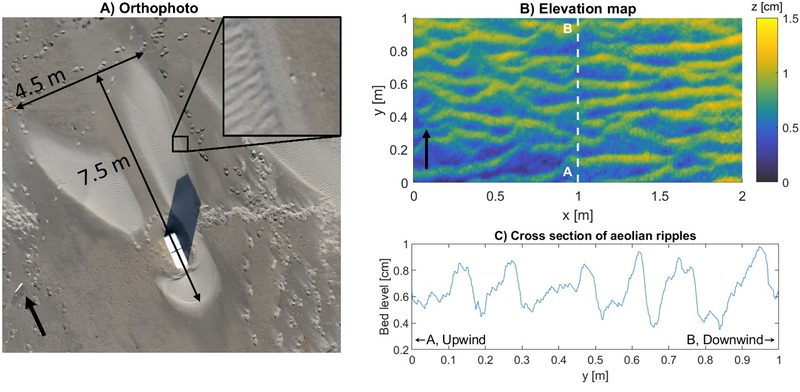Daan W. Poppema1,2*, Kathelijne M. Wijnberg1, Jan P.M. Mulder1 and Suzanne J.M.H. Hulscher1
1 University of Twente; 2 Delft University of Technology
*corresponding author:
Introduction
Structure-from-motion (SfM) photogrammetry computationally combines photos from different points of view into a 3D model of an object or area. This technique can be used at the beach to make high-resolution DEMs (digital elevation models), point clouds and orthophotos (distortion-free top views). During my PhD on the morphological effects of beach buildings, I used SfM photogrammetry to take millimeter-scale measurements of beach topography around scale models of buildings. This contribution will focus on showcasing the power of SfM photogrammetry for high resolution topography measurements and possible spin-off opportunities this dataset may offer.
Methods
During the experiments, boxes were placed on the beach as scale models of buildings, at Terschelling, the Sand Motor and Noordwijk. Beach topography around the scale models was measured, for areas of up to 60×60 m. For these measurements, 1000 to 2000 photos were taken from a height of approximately 5 m, using a drone or a camera on a telescopic stick. Using SfM photogrammetry, this resulted in orthophotos and digital elevation models with a resolution of approximately 2 mm (Figure 1).
Data availability and use cases
The topographic datasets are publicly available online (Poppema et al., 2021; 2022) and can be used to further study morphological effects of beach buildings. Moreover, because of the extremely high spatial resolution, the data could also be used to explore or study completely different topics, e.g. bed roughness or the size and shape of aeolian ripples.

Figure 1: SfM results. A) Orthophoto of deposition (lighter colored sand) around scale models. B) DEM of beach area with aeolian ripples, unaffected by scale models. C) Cross section of the dashed line in B).
References
Poppema, D.W.; Wijnberg, K.M.; Mulder, J. P.M.; Hulscher, S.J.M.H. (2021): Experimental data of Deposition patterns around buildings at the beach: effects of building spacing and orientation. 4TU.ResearchData. Dataset. https://doi.org/10.4121/16860145.v3
Poppema, D.W.; Wijnberg, K.M.; Mulder, J.P.M.; Vos, S.; Hulscher, S.J.M.H. (2022): Experimental data of The effect of building geometry on the size of aeolian deposition patterns: scale model experiments at the beach. 4TU.ResearchData. Dataset. https://doi.org/10.4121/21285939.v2
I. Surname1*, F.N. Another-Surname2 , Y. Next-Surname2
1 University Name, Country; 2 Organization Name, Country
* Corresponding author: mail.name@organization.org


